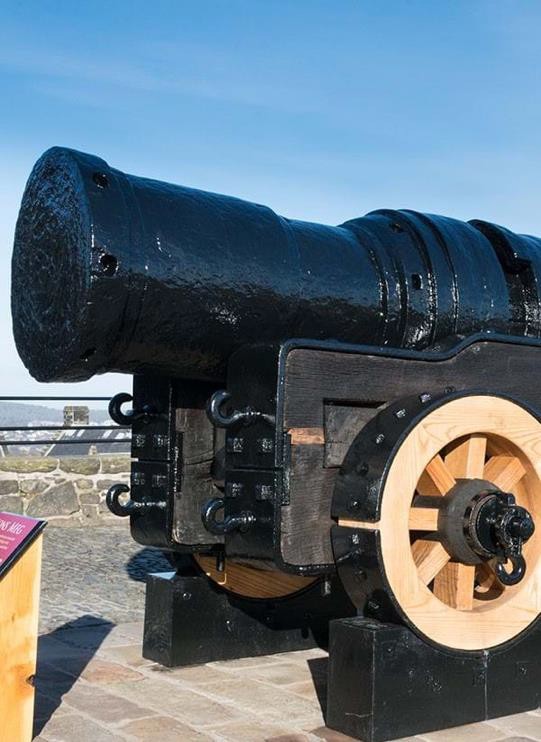Edinburgh
Located at 56 degrees north latitude, is similar to Kodiak, Alaska distance from the equator. As it’s almost the summer solstice the sun sets at 10:15 with bright morning skies at 4:15 AM. The geology of Scotland is quite interesting, but more on that later. Buildings are made to last.
 Sandstone is used extensively throughout the country. The color varies and due it’s porous nature, the stone shows the stains of the centuries.
Sandstone is used extensively throughout the country. The color varies and due it’s porous nature, the stone shows the stains of the centuries.
Edinburgh has an imposing air. The weather is fickle. The morning mist frequently hangs over the city until the afternoon. The old town, with its variegated sand stone set against a grey sky, feels very medieval and brooding. A perfect setting for Scottish novel.

The center piece of the city is Edinburgh castle. The castle, originally constructed in the 11th century, is built atop a volcanic plug. The castle is a bit more than one mile from the southern shore of the Firth of Fourth. A firth is effectively a fjord. The castle has the distinction of being under siege more than 23 times. The oldest building remaining in the castle complex is the chapel of St Margaret, built in the 12th century.
This picture was pulled from the web, as massive grandstands have been erected at the castle entrance in preparation for the Royal Tattoo. This year the RAF is the lead service, with additional
showcases from Norway, Australia, U.S and Switzerland. As always, there will be bagpipes, fifes and drums.
The cannon below, on display at the castle, Mons Meg, was once seen as cutting edge military technology. Given to King James II in 1457, the six-tonne siege gun could fire a 150kg gunstone for up 2 miles. Her muzzle had a 20” diameter. She is named after the Belgian town where she was made. (Why are canons, bombers and ships – “she/her” – do they have the right to self identify?)

In 1460, James II had Mons Meg hauled 80km (50 miles) to the siege of Roxburgh Castle. A team of oxen moved her little more than 3 miles a day. The unlucky king was killed there when another of his cannons exploded.

When Mary Queen of Scots married in 1558, Mons Meg fired a gunstone over the city in celebration: it landed in what is now the Royal Botanic Garden. Her barrel finally burst in 1681.
The city commemorates distinguished Scotsmen. There is a statue dedicated to James Maxwell. He was the first scientist to describe electricity, magnetism and light, as different manifestations of the same phenomenon. We wouldn’t have cell phones without Maxwell. I wish he had developed a formula for ridding statues of pigeon droppings. There’s quite a bit on his statue.
There are beautiful green ways and parks in the city. The monument dedicated to Sir Walter Scott is particularly picturesque.
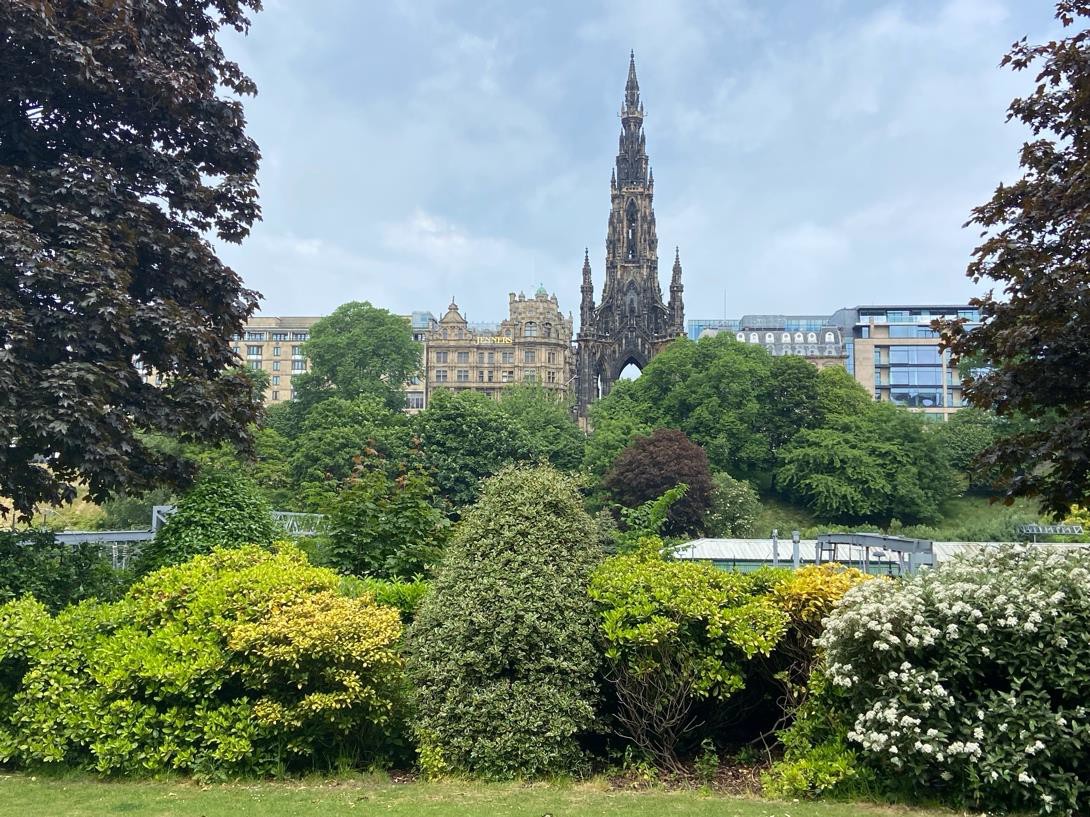
Scotland has contributed in fields of engineering, science, literature, economics and philosophy. They may have been the best educated country of the 16th – 19th centuries. As a result of the Protestant reformation, Scotland made education compulsory for boys and girls at the age of 5. With the change from the Catholic Latin liturgy, scriptures could be available to anyone. A godly citizen needed to be able to read and understand the Bible.
I didn’t have nearly enough time in Edinburgh. I hope to come back sometime and spend at least four days exploring the city, it’s museums and the underground town.
The Highlands
Monday morning we headed north. There was a brief stop at Queensferry . From this vantage point you can see three bridges each built in a different century. The oldest, the Fourth Bridge, was built in 1890. The other two bridges, both christened by Elizabeth II, were completed in 1964 and 2017.
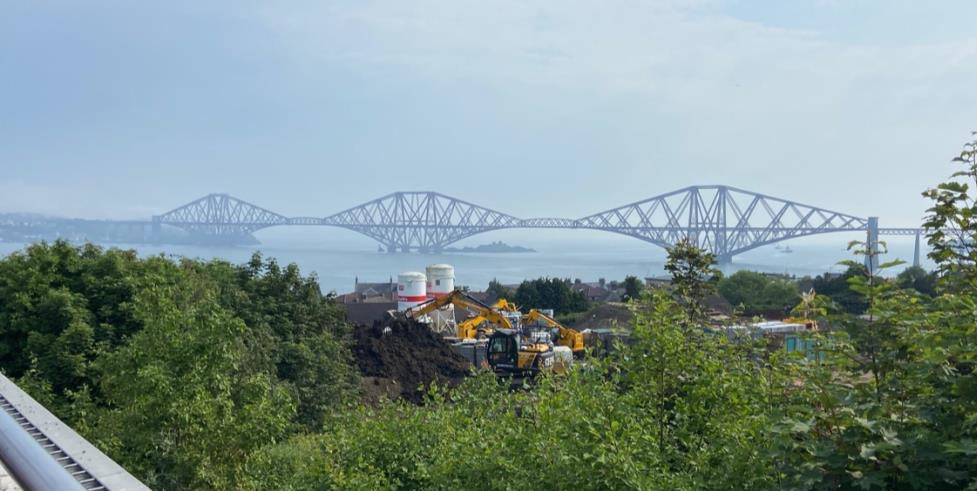 The Tay rail disaster of 1873 was caused by piers that had been weakened by a severe storm. Any new railroad bridge had to be sturdier. Hence there was a competition for the proposed bridge which would span the Firth of Fourth. The elegant cantilever design won the prize and the contract.
The Tay rail disaster of 1873 was caused by piers that had been weakened by a severe storm. Any new railroad bridge had to be sturdier. Hence there was a competition for the proposed bridge which would span the Firth of Fourth. The elegant cantilever design won the prize and the contract.
The hike of the day took us to Pitlochry, site of one of many hydroelectric dams. There’s a 310m salmon ladder built to bypass the dam. Scotland uses water and wind power extensively. They also have a nuclear plant that will be decommissioned shortly. However, their homes are

predominately heated by oil or natural gas. In a cold winter, pensioners decide between food and heat.
We had lunch in the town. The shopkeepers have a good sense of humor. Lunch at a local pub was excellent, a local beer with salmon three ways.

As you travel north, the landscape changes. The Highland Boundary Fault separates the more rugged Highlands from the Lowlands. The land has been shaped by time. Three tectonic plates grinding and constantly but slowly pushing against each combined with glacial erosion gave rise to a rich sculpted landscape dotted with lochs and traversed by rivers.
The Appalachian Mountains share the same characteristics as much of the British Isles. As soon as we crossed the Highland Fault the hills became much more rugged. There were more conifers, steeper, rocky hillsides and less arable land.


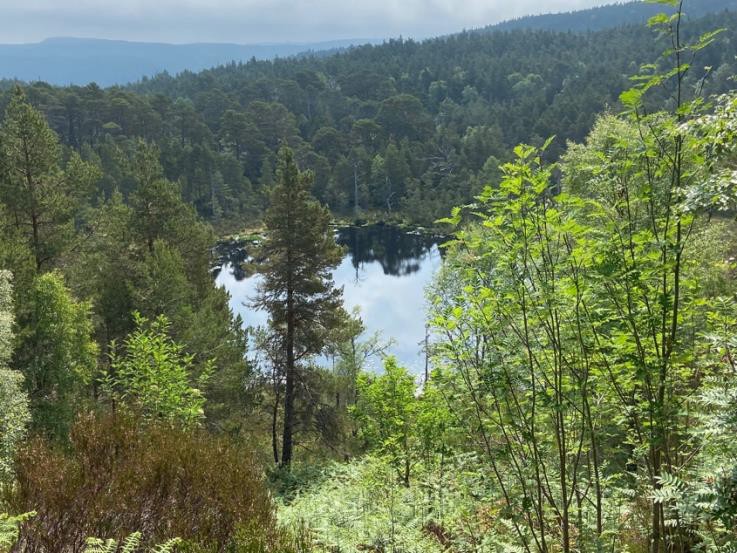
We had a brief stop at a working sheepdog farm. It was fascinating. The dogs are well trained and respond to their own unique set of commands, spoken and whistled. Neal, the Shepherd and his brother are the last two shepherds in the area southeast of Inverness. When he was young, there were 600,000 sheep on the farms and several shepherds. Now there are 60,000 sheep. He believes sheep herding in this area will end when he and his brother retire.
Much of the land in Scotland is privately owned but there is public access. The next mornings hike however was in the Glen Affric National Nature Reserve. The Dog Falls trail runs through an ancient Caledonian pine forest. There are waterfalls and quaint bridges along the route. The steeper slopes have well crafted stone steps.


The afternoon was spent at Castle Urquhart on Loch Ness. The castle was historically important. It’s strategic position on a promontory facilitated both defense and control of the 23 mile loch. During the
Wars of Scottish Independence- the Scot’s were fighting to stay independent from the English – control of Castle Urquhart passed back and forth between the Scots and the English.
In 1688, the English held the castle with a garrison of 200 troops. A Jacobite force of 500, followers of the exiled King, laid siege. After a major Jacobite defeat, the English blew up the castle on leaving the Highlands.
The shell of the castle with a trebuchet in the foreground is an impressive site. The weather was wonderful and strolling through the ruins was very interesting. Our visit concluded with an excellent encapsulated talk about the castle and the Jacobite cause, in a proper Scottish brogue.
History – ancient and modern
Early the next morning, we were off to Clava Cairns. The structures here are older than the pyramids. 4,000 years ago, the local inhabitants built stone structures aligned to signal the summer solstice. There are other buildings on the site that might have been gathering spaces or tombs.


There is no written account from the era. Archaeologists are studying artifacts and the site in an effort to understand why the cairns were built. The site is atypical as it seems the construction of the buildings was an art that was developed even further north. Other archeological locations are to the north in Ornkey. While Stonehenge, much further to the south and more modern than Clava Cairns exhibits a similar style.
Next up was the scared site of the Battle of Culloden. Here, on April 16, 1746, gallant Highlanders fought for Scotland and Prince Charlie. The battle lasted less than an hour. More than 4,000 troops under the 25 year old Duke Cumberland faced 2000 Jacobites.
The Jacobite cause was an effort to restore the old order of the Scottish kings. England and Scotland shared a king when Elizabeth I died. Yet England and Scotland to this day are separate countries with different customs. The Jacobite cause was steeped in restoring the blood line of the Scottish royals and the old order. Highlanders could be found on both sides
of the battle field. There were also Irish and English who fought with the Jacobites.
Prince Charlie had landed in England with money and a small following. By the time he neared Inverness, he had garnered support from several clans. The government forces and the Jacobites had agreed to battle on the moor of Culloden on the 16th. The night before the battle, in hopes of

striking a final blow against the government forces, a large contingent of the Jacobites traveled through the night in order to catch the government troops by surprise. But they were stymied by bad weather and arduous conditions. They didn’t get to their objective and by the time they returned to the moor for the battle, they were exhausted.
The Jacobites fired the opening canon shot and then charged the enemy lines 250 meters away. Cumberland fired his canons and as the Jacobites drew closer, three rows of musketeers in turn fired their rifles.
The Jacobites broke through the line but the government forces had been disciplined and utilize a new technique to disable the charging
army. The Highlanders, charged with their right arm raised with a holding their sword, while the left arm held held a small shield and dagger. The government troops, instead of attacking the man charging toward them, attacked with an upward thrust the man to his left who had a raised arm.
 The blow would pierce through the ribs and dealt a deadly blow. With the Jacobites upon the government troops, Cumberland gave the command, “give no quarter “. The fleeing Jacobites were slaughtered, either stabbed to death on the battlefield caught in gun fire from their flank.
The blow would pierce through the ribs and dealt a deadly blow. With the Jacobites upon the government troops, Cumberland gave the command, “give no quarter “. The fleeing Jacobites were slaughtered, either stabbed to death on the battlefield caught in gun fire from their flank.
At the end of the battle, the government troops went into Inverness and killed any male between 10 and 70 who was sympathetic to the Jacobite cause. In the Highlands, it was forbidden to wear the kilt, to gather in numbers greater than six or to speak Scottish.
The locals arrived at the moor two days later to bury the dead. The men, identified by their kilt, were gathered by clan. Each clan has a small monument at the spot where they gathered for the battle.
Prince Charlie had escaped and was secreted out of the country. Though several Highlanders wanted to continue the fight the Prince said their battle must end.
Elgin
 Elgin is a small town, near the Culloden Moor battle site. It is home to one of the oldest woolen mills in the UK. Johnstons has been making fine quality woolen products since 1797. The are perhaps, the only vertically integrated mill left in Europe.
Elgin is a small town, near the Culloden Moor battle site. It is home to one of the oldest woolen mills in the UK. Johnstons has been making fine quality woolen products since 1797. The are perhaps, the only vertically integrated mill left in Europe.
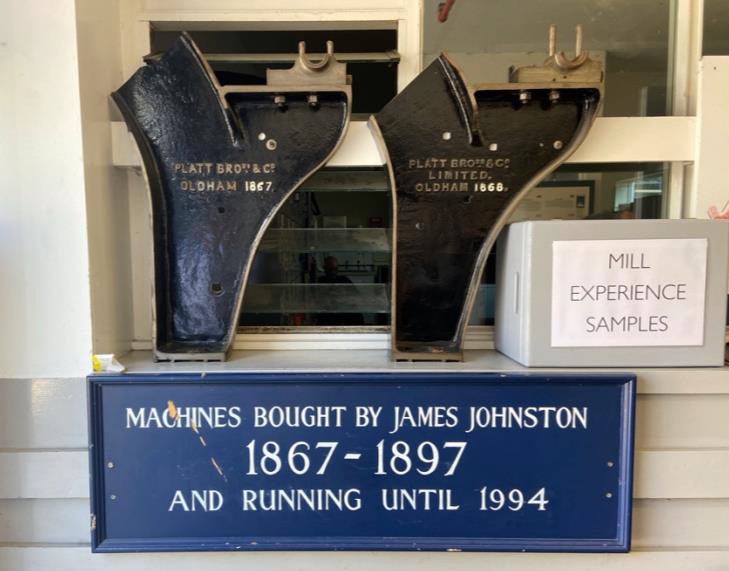
They source wool from Australia, New Zealand, Mongolia and Peru. The bulk product is treated, dyed, carded, spun into spools and woven into beautiful, soft, warm products. They provide woolen material to many luxury brands. The Burberry plaid was visible throughout the factory.
When Queen Victoria visited Balmoral she was distressed at seeing her gardeners in a black and white livery tending the grounds. The Johnson mill was commissioned to develop a tweed which would camouflage the workers. The tweed they designed is still used today.They employ over 1500 people at two sites in Scotland. The equipment has evolved over time with laser alignment and many computerized checks. However, they still need a conscientious workforce to guarantee the quality. The factory and storerooms were neat and well organized. The factory grounds are beautiful with exotic trees, a vegetable gardens and flower trimmed paths.
St. Andrew’s
When I saw St. Andrew’s on the itinerary I immediately associated it with the Open, A wind swept link course hosting golf’s best players.
 I didn’t know the town could captivate me with its medieval architecture, cobbled streets, ancient university and North Sea summer breeze.
I didn’t know the town could captivate me with its medieval architecture, cobbled streets, ancient university and North Sea summer breeze.
St. Andrew’s, named for the relics of the Saint, was a significant Christian pilgrimage site. Pope xxx declared that a pilgrimage to St. Andrew’s was equivalent to a pilgrimage to Rome.
Devote and wealthy Christians living north of the Alps would seek eternal salvation by charting a course to St. Andrew’s. The 15th century city had the grandest cathedral in the British Isles.
But it also had a University and free thinkers who had embraced the teaching of Martin Luther and Calvin. The Catholic Church of Scotland ruled with an iron fist. Heresy was not tolerated. The punishment was torture and death.
Emotions were high when John Knox preached in the town and condemned the church. The prior month, another cleric had been burned at the stake. The students broke into the Cardinal’s home and hung him out the window. The crowds descended on the cathedral destroying the stain glass windows, defacing the statues and carrying off anything of value. Many buildings in St. Andrew’s have stones from the old cathedral.
What’s left is a ruin, perhaps an allegory or a warning. The head stones and graves add to the mystique. As you look out to the North Sea and the stretch of beach, it’s easy to imagine how a 14th century pilgrim arriving by sea would have been gob smacked at seeing St. Andrew’s.
 We walked further into town and through the university buildings. It was graduation week and the campus seemed even more scholarly with the new graduates in there black gowns with brilliant colored cowls. Our guide took us into the university chapel, St. Salvador. Though damaged during the reformation, it’s stained windows were beautifully restored. There was a choral concert of sacred music that had just started when we arrived. The music was magnificent and the setting, a gothic cathedral with excellent acoustics, elevated the performance to ethereal.
We walked further into town and through the university buildings. It was graduation week and the campus seemed even more scholarly with the new graduates in there black gowns with brilliant colored cowls. Our guide took us into the university chapel, St. Salvador. Though damaged during the reformation, it’s stained windows were beautifully restored. There was a choral concert of sacred music that had just started when we arrived. The music was magnificent and the setting, a gothic cathedral with excellent acoustics, elevated the performance to ethereal.
I was able to stay for the enter concert. I love traveling because you never know when your going to experience something that you didn’t even know you needed.
 The next morning we strolled the back of the old course at St. Andrew’s. The grounds are public and anyone can walk the course. There is even a local road that cuts across the 18th fairway. There are actually 5 courses at St.
The next morning we strolled the back of the old course at St. Andrew’s. The grounds are public and anyone can walk the course. There is even a local road that cuts across the 18th fairway. There are actually 5 courses at St.
Andrew’s. The Old Course as the caché and golfers from all over the world queue up to play the course. The only requirement when reserving a spot is an established handicap. The picture to the left is of a cluster of bunkers on the back nine.
Isle of May
5 miles off the coast is the Isle of May. It’s officially been a nature sanctuary since 1956. There are 200,000 birds on the island, half of them are puffins.
In 1635, King Charles I granted a patent to build a beacon on the island. It was a rough affair and in 1814 a new design was commissioned by the crown. It was powered by coal and used 400 tons of each year. The coal was hoisted up with buckets to the top of the structure. The current lighthouse is fully automatic and solar powered.
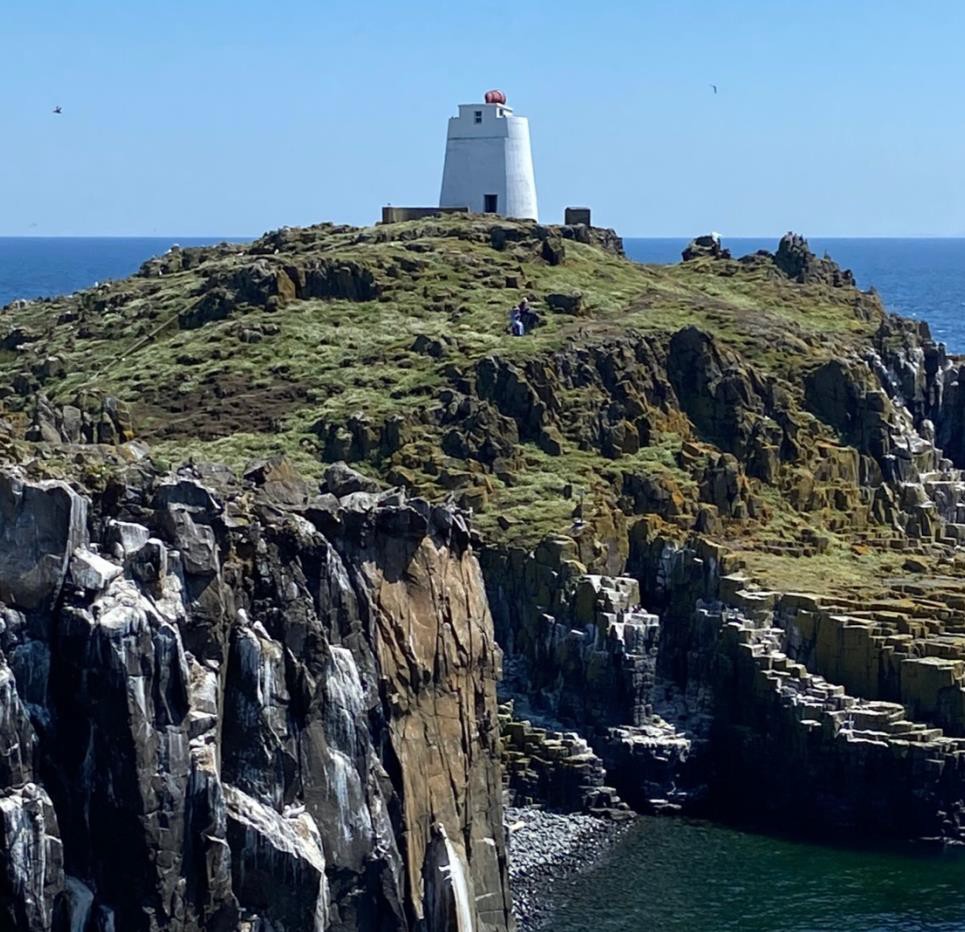


The steep cliffs camouflage the caves. The island was a stop over for smugglers. Also, during times of forced conscription, eligible males would elude the navy by hading to the North Shore.
The island also housed a monastic order. The monks, in addition to prayer, would care for any sailors or passengers who required quarantine.
The Falklands
Our last hike of the Scotland trip was through a forest that lead to Falkland, the ancestral seat of Scottish royalty. It was another beautiful hike through a forest with old growth trees.


The trail took us into Falklands, the ancestral seat of Scottish royalty. We toured the castle and admired the grounds.


Trivia, Royal garments were never washed due to the dyes in the fabrics and ornate decorations. To keep the vestments from being infested with bugs, they were hung over the castles latrine. The stench was so bad that it kept the bugs away.
Also, the first tennis court ever built is on the grounds of the castle.
Tennis was originally played in an enclosure, much like a giant racquetball court. Mary, Queen of Scots played tennis and was chastised by the clergy for wearing knickers so she could more easily hit the ball. In royal tennis, a servant threw a ball to start a volley. Most court clothes were too restrictive to allow either bending to pick up a ball or an over head serve. Lawn tennis wasn’t established until the 1870’s.
Potpourri
J. K. Rawlings wrote her first Harry Potter book from a coffee shop in Edinburg. She lived in council housing. Now that Elizabeth II has died, she is the wealthiest woman in the UK.
Children must have 2 years of Gaelic in school.
All laws are written in Scottish, Gaelic and English.
The term earmark is derived from a form of Scottish punishment. A seller found cheating on the scales on market day was sent to the center of the square where is ear was nailed to the stocks. After standing there for the day, his earlobe would be ripped or at least scarred, when he was allowed to leave the square. So, anyone could identify a vendor who had cheated at the scales by an “earmark”.
Outlander has filmed extensively in Northern Scotland, primarily in the town of Falkland. Though the story, with time travel and charismatic romantic main characters, is fiction. The fabric of the books and the series is built on historical events and people.
Slavery was outlawed after a freed Jamaican slave sued for his freedom. In 1788, a majority in Scotland’s highest court ruled that Joseph Knight, who had been brought from Jamaica by his owner Sir John Wedderburn, could not be forced to return as a slave to the Caribbean. Unlike the Mansfield judgement in England, the ruling declared unequivocally that slavery could not exist in Scotland.
Loch Ness monster myth started in 624 AD when a holy man came and was asked to rid the Loch of that terrible worm that has taken my cattle and one of my men. Loch Ness is the second deepest loch in Scotland at 800 ft.
The Scottish crown is older than the English crown, as Cromwell melted down the English crown in 1649 after the execution of Charles I.

 The Scottish “coo”, a hairy cow breed for cold weather.
The Scottish “coo”, a hairy cow breed for cold weather.
A Victorian mailbox, circa 1860 in Falklands. The view of Castle Urguhart from Loch Ness

